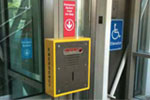
Hold the Phone
Emergency communications: Is it time for VoIP to shine?
- By Samuel Shanes
- Jul 01, 2011
Colleges are removing analog phones from dormitories for a variety of reasons. Students don’t use them because they have cell phones. In an emergency, equipment failure due to a wall-connected phone’s age can quickly turn into a liability. The cost of maintaining the necessary legacy infrastructure might finally outweigh the upgrade option, prompting the change. Or it could also be a desire to standardize on IP .
Whichever the case, the problem is anything but trivial. Phasing out legacy emergency communications capabilities without a migration plan will cut the vital link between those seeking help and security staff. The importance of such a communications channel cannot be overstated from both legal and public relations perspectives.
So what are the options? Phones can be installed in dormitory hallways for emergency use. VoIP is quickly becoming a de-facto standard for communications on IP networks, so naturally office VoIP telephony is viewed as an alternative for emergency communications. However, business-grade VoIP phones do not possess the necessary durability, are not designed with emergency communications in mind and are not ADA compliant.
The proper way is to embrace and benefit from IP while keeping reliable emergency communications a priority. Upgrading to VoIP emergency communications is an attractive and inexpensive option because most campuses are already equipped with necessary IP infrastructure.
DePaul University Up grade
As facilities are moving to IP for buildingwide use, it becomes economical to install VoIP emergency phones in hallways, stairwells and elevators along with IP-based video surveillance and access control systems. VoIP emergency phones are designed for emergency situations, and so their primary function is to establish reliable communications in a time of crisis. Emergency phones are ADA compliant, and their ruggedness gives passersby a sense of security.
For DePaul University, upgrading to VoIP emergency phones was not a hard decision to make. Founded in 1898, DePaul University is the largest private institution in Chicago, with more than 23,000 students.
“Fortunately, I’m set in an institution that is big on safety,” said Bob Wachowski, director of public safety for DePaul University. “There is a capital funding program in place, and DePaul has come a long way. The university administration is very supportive of my needs, and that is unique.”
Wachowski recently upgraded the college’s analog emergency phones to new VoIP emergency phones manufactured by Talk-APhone. The new phones are SIP-compatible and work on the college’s IP PBX system.
As an added benefit, the new emergency phones can be paged at high volume via mass notification software, which allows the public safety staff to issue targeted alerts to segments of a campus in groups or individually. The software automatically tests and verifies connectivity of voice-over-IP phones and sends e-mail alerts when it detects failure.
Wachowski also recently installed Talk-A-Phone’s new generation of all-LED blue lights on 90 existing emergency phone towers.
“You can see them from about everywhere you are on campus,” Wachowski said. “They help our students feel safe and they are a deterrent to crime.”
The new units have ultra-bright, all-LED blue lights, and they feature 209 lumens peak rating and prismatic pattern to increase visibility at greater distances. The units’ All-LED construction significantly increases their life span.
“Our biggest crime is theft of unattended items,” Wachowski said. “But some of our issues occur late at night, so the phone towers assist the students. I recently met with the student government association to help us promote use of them. Our campus tour guides already promote them. We like to make every student aware of the emergency call towers.”
Emergency Phones in Classrooms
The situation in classrooms is slightly different, yet it resonates with the issue of migration to alternative technology. Traditionally, classrooms are equipped with announcement speakers only, leaving emergency communications out of the picture. But what if the students or staff in a classroom need to reach out to university security during an emergency?
With growing concerns for student safety on campuses and widespread adoption of mass notification technology over existing IP infrastructure, it is reasonable to offer two-way communication capabilities inside classrooms.
A VoIP emergency phone serves a dual role. On one hand, it’s a reliable and robust emergency communications device with unparalleled flexibility to work on SIP-compliant VoIP networks. On the other hand, it’s a durable and loud paging speaker, capable of outputting sound louder than 100 dB. Voice-over-IP emergency phones can also be integrated with mass notification platforms to form a powerful, multi-layer mass notification solution.
IP empowers communications. And now that emergency phones are available with VoIP, security professionals can take full advantage of their IP infrastructure.
This article originally appeared in the July 2011 issue of Security Today.